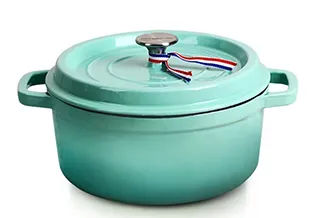
The Origin of the Name Dutch Oven and Its Historical Significance
The Origins of the Dutch Oven Understanding Its Name
For anyone who enjoys cooking, the Dutch oven is an indispensable tool found in kitchens around the world. This heavy, heat-retaining pot is renowned for its ability to evenly distribute heat, making it perfect for a variety of cooking methods such as braising, baking, and simmering. Despite its widespread use today, the name “Dutch oven” can be somewhat misleading and raises the question why is it called a Dutch oven?
To trace the name's origins, we must journey back to the 18th century. The term “Dutch oven” actually refers to a method of casting iron that was perfected in the Netherlands. The Dutch had developed a new way to produce cast iron cookware that was more efficient than what was available in England at the time. These pots were designed to be versatile, with a thick body that could handle high heat and a tight-fitting lid that retained moisture during cooking. This technology allowed for the creation of cookware that could be used over an open flame, which was crucial for cooking during that period.
The Origins of the Dutch Oven Understanding Its Name
The popularity of Dutch ovens in England can be traced back to the 1700s when British craftsmen began to replicate the Dutch methods of making these pots. The pots became increasingly popular among the British aristocracy. In fact, the term “Dutch oven” was likely popularized in England, where the pot became a staple for both affluent households and the working class. The name reflects the pride the English took in the Dutch craft of iron founding, even while they were also establishing their own versions of the pot.
why is it called a dutch oven

As the Dutch oven journeyed across the Atlantic, it became an essential tool for early American settlers. With its ability to withstand direct heat and retain moisture, it was perfect for cooking in the harsh outdoor conditions faced by pioneers. Campfire cooking quickly adopted the Dutch oven, and it became synonymous with outdoor cooking across America. Its durability and versatility made it a favorite not only for camping and outdoor pursuits but also in traditional home kitchens.
Interestingly, the way we use Dutch ovens today has expanded significantly. Modern versions of Dutch ovens are often made of enameled cast iron, allowing for easier cleaning and a wider range of colors, but their fundamental purpose remains the same. They are still used for braising meats, stewing vegetables, and even baking bread—all tasks that highlight the pot's ability to retain heat and moisture.
Moreover, the Dutch oven has also found a place in contemporary culinary culture, as chefs and home cooks alike have embraced its utility. Its ability to serve as a cooking vessel for various cuisines tied to different cultures demonstrates its universal appeal. From hearty French coq au vin to classic American chili, the dishes prepared in a Dutch oven are as diverse as the individuals who use them.
In summary, the name “Dutch oven” is reflective of its roots in the Netherlands, where the concept of cast iron cookware was developed and perfected. Over the centuries, it transitioned from Dutch ingenuity to British popularity, and eventually to a staple in American kitchens. The Dutch oven symbolizes not just a cooking method but also a blend of cultural heritages that have embraced this remarkably versatile cooking tool. Whether you are an experienced chef or a novice home cook, the Dutch oven remains a timeless instrument that continues to bring people together around the dinner table.
-
Premium Skillets Sets - Porcelain & Enamel Covered Cast Iron Cookware for Every KitchenNewsJun.24,2025
-
Premium Deep Cast Iron Pan – Versatile Enameled & Grill Options, Perfect for Frying and SaucesNewsJun.10,2025
-
Chipped Enamel Dutch Oven – Durable & Stylish Kitchen Essential for Even CookingNewsJun.10,2025
-
Best Cast Iron Cookware Set Sale Durable Pots & Woks DealsNewsJun.09,2025
-
Hanging Dutch Oven Oven Safe & Lid IncludedNewsJun.09,2025
-
16 Inch Dutch Oven - Heavy Duty Cast Iron for Large MealsNewsJun.09,2025


